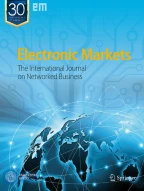Abstract
The debate about the relative merits of open vs. proprietary standards is long and ongoing. Proponents of open standards argue that they are good for society as they encourage adoption, have lower risk, and increase interoperability between technologies. On the other hand, proponents of proprietary standards maintain that monopolistic returns are justified given huge upfront and ongoing investments. While there are merits to both sides of this debate, we take a more objective approach in evaluating whether it makes sense to develop or invest in open standards. We collect investors’ reactions to Extensible Markup Language (XML) schema announcements and compare these with estimated returns for the same stock to determine whether the returns were above or below normal. We find that investors prefer proprietary XML schemas to open XML schemas by as much as 28,000%. We also find that this preference has been stable over time except in 2001 – the period of the dot com bubble burst - when investors temporarily preferred open standards. We attribute these results to two things. First, expected returns from monopoly control of proprietary standards, even though uncertain, are often worth more than those expected from open standards. Second, it seems that the markets are still unsure of the monetary benefits of open standards to the firm. Thus, companies that embrace open standards will have to better communicate to the investors the value proposition of open standards if they want to generate positive reactions on their open standardization efforts.
Similar content being viewed by others
References
BBCNews (2002). China in DVD royalty row. Retrieved March 7, 2002 from http://news.bbc.co.uk/2/hi/business/1860621.stm.
Berlind, D. (2002). Open source: IBM’s deadly weapon. Retrieved March 10, 2011 from http://www.zdnet.com/news/open-source-ibms-deadly-weapon/296366.
Brown, S. J., & Warner, J. B. (1985). Using daily stock returns: the case of event studies. Journal of Financial Economics, 14, 3–31.
BusinessWire (2002). Large capacity optical disc video recording format ‘Blu-ray Disc’ established. Retrieved March 10, 2011 from http://www.sony.net/SonyInfo/News/Press_Archive/200202/02-0219E/.
Caceres, M. (2006). Client-side web applications (Widgets) requirements. Retrieved March 10, 2011 from http://www.w3.org/TR/WAPF-REQ/.
Dranove, D., & Gandal, N. (2003). Surviving a standards war: lessons learned from the life and death of DIVX. CEPR Discussion Paper No. 3935.
Foley, M. J. (2007). Microsoft: why the ODF vs. OOXML battle matters. Retrieved March 10, 2011 from http://www.zdnet.com/blog/microsoft/microsoft-why-the-odf-vs-ooxml-battle-matters/290.
Gartner, Inc. (2011). Gartner hype cycle. Retrieved March 10, 2011 from http://www.gartner.com/technology/research/methodologies/hype-cycle.jsp.
Inceoglu, F., & Park, M. (2003). Diffusion of a new product under network effects: the case of U.S. DVD player market. Unpublished Manuscript, Boston University.
ITU-T (2010). Definition of “open standards”. Retrieved October 21, 2011 from http://www.itu.int/en/ITU-T/ipr/Pages/open.aspx.
Kanellos, M. (2008). Blu-ray victory means royalties, royalties, royalties. Retrieved March 11, 2011 from http://news.cnet.com/8301-10784_3-9874317-7.html.
Krechmer, K. (2005). The meaning of open standards. 38th Annual Hawaii International Conference on System Sciences.
Lemer, J., & Tirole, J. (2005). The economics of technology sharing: open source and beyond. Journal of Economic Perspectives, 19(2), 99–120.
Markus, M. L., Steinfield, C. W., Wigand, R. T., & Minton, G. (2006). Industry-wide information systems standardization as collective action: the case of the U.S. residential mortgage industry. MIS Quarterly, 30(Special Issue on Standardization): 439–465.
Maxwell, E. E. (2006). Open standards, open source, and open innovation: harnessing the benefits of openness. Innovations: Technology, Governance, Globalization, 1(3), 119–176.
Parker, G. G., & Alstyne, M. W. V. (2005). Two-sided network effects: a theory of information product design. Management Science, 51(10), 1494–1504.
Patrizio, A. (2007). Who is drawing out the High-Def DVD stalemate? Retrieved March 11, 2011 from http://www.internetnews.com/storage/article.php/3671091.
Redfearn, N. (2009). Patent pools in china. Retrieved March 11, 2011 from http://www.iam-magazine.com/issues/article.ashx?g=18282a7c-2e62-4b29-8560-4c2d0b42c64b.
Shapiro, C., & Varian, H. R. (1999). Information rules: a strategic guide to the network economy. Cambridge: Harvard Business School Press.
Shimel, A. (2010). Oracle to open source: drop dead! Retrieved March 11, 2011 from http://www.networkworld.com/community/blog/oracle-open-source-drop-dead.
West, J. (2003). How open is open enough? Melding proprietary and open source platform strategies. Research Policy, 32(7), 1259–1285.
West, J. (2004). What are open standards? Implications for adoption, competition and policy. Standards and Public Policy Conference. Retrieved October 21, 2011 from http://www.chicagofed.org/news_and_conferences/conferences_and_events/files/west.pdf.
West, J. (2006). The economic realities of open standards: black, white and many shades of gray. Standards and public policy. Cambridge: Cambridge University Press.
Wikipedia (2011). List of XML schemas. Retrieved March 10, 2011 from http://en.wikipedia.org/wiki/List_of_XML_schemas.
Author information
Authors and Affiliations
Corresponding author
Additional information
Responsible editor: Rolf T. Wigand
Rights and permissions
About this article
Cite this article
Aggarwal, N., Dai, Q. & Walden, E.A. Are open standards good business?. Electron Markets 22, 63–68 (2012). https://doi.org/10.1007/s12525-011-0078-7
Received:
Accepted:
Published:
Issue Date:
DOI: https://doi.org/10.1007/s12525-011-0078-7
